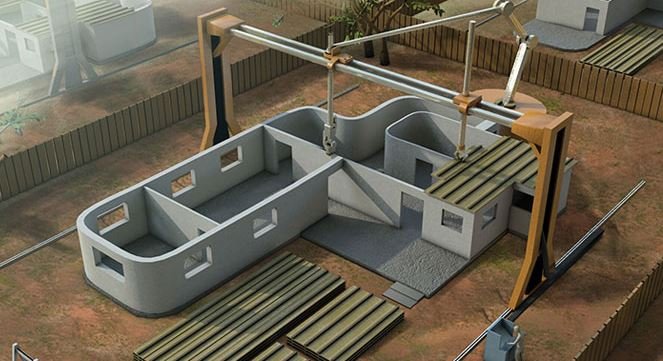3D-Printed Construction
- By -Peter
- Posted on
- Posted in Modern Architecture
3D printing technology is transforming the construction industry by revolutionizing how buildings are designed, fabricated, and constructed. This article explores the capabilities, advantages, and challenges of 3D-printed construction methods in modern architecture.

How 3D Printing Works in Construction
Additive Manufacturing Process
3D printing in construction utilizes robotic arms or gantry systems to deposit layers of concrete or other building materials based on digital models. This additive manufacturing process enables precision, speed, and customization in building construction.
Types of 3D Printing Techniques
- Contour Crafting: Large-scale 3D printing technique that constructs entire buildings layer by layer, reducing construction time and labor costs.
- Selective Deposition: Precision-based method that deposits materials in specific locations to form structural components and architectural features with minimal waste.
Advantages of 3D-Printed Construction
Speed and Efficiency
3D printing accelerates construction timelines by automating repetitive tasks and reducing manual labor. It enables rapid prototyping, on-site fabrication, and faster project completion compared to traditional methods.
Cost-Effectiveness
Lower material waste, reduced labor costs, and optimized construction processes contribute to cost savings in 3D-printed construction projects. Initial investments in technology and equipment are offset by long-term efficiency gains.
Sustainability and Environmental Benefits
Resource Efficiency
3D printing minimizes material waste by using precise quantities of construction materials. It promotes sustainability through reduced carbon emissions, energy conservation, and recycling of materials in building fabrication.
Design Flexibility and Customization
Architects leverage 3D printing technology to create intricate designs, complex geometries, and customized building components. Design freedom allows for innovative architectural forms and functional optimizations in building construction.
Applications of 3D Printing in Construction
Residential Housing
3D-printed homes are emerging as affordable housing solutions in various regions worldwide. Projects like the “Apis Cor” house in Russia demonstrate the feasibility of printing entire houses in a matter of days.
Infrastructure and Urban Development
3D printing technology extends to infrastructure projects such as bridges, pavilions, and emergency shelters. It offers rapid deployment capabilities, cost-effective solutions, and resilience in disaster response and urban development.
Challenges and Considerations
Technological Limitations
Scaling up 3D printing for larger structures poses challenges in equipment size, mobility, and material handling. Innovations in robotic systems and material science are necessary to address structural integrity and durability concerns.
Regulatory and Compliance Issues
Navigating building codes, zoning regulations, and safety standards for 3D-printed constructions requires compliance and adaptation of existing legal frameworks. Collaboration among stakeholders ensures adherence to quality and safety protocols.
Examples of 3D-Printed Construction Projects
- The YHNOVA House, FranceDesigned by XtreeE, the YHNOVA House showcases 3D-printed concrete walls and partitions, integrating sustainable building practices and innovative design solutions.
- TECLA, ItalyTECLA, a collaboration between Mario Cucinella Architects and WASP, features a 3D-printed eco-habitat using locally sourced raw materials and organic construction techniques.
Future Directions: Innovations in 3D-Printed Construction
Advanced Materials and Robotics
Research in bio-based materials, composite fibers, and robotic automation enhances structural performance and construction efficiency in 3D printing. Multi-material printing capabilities expand design possibilities and functionality.
On-Demand Construction and Customization
Future trends in 3D printing envision on-site fabrication of customized buildings tailored to specific user needs and environmental conditions. Adaptive technologies and digital fabrication tools support sustainable urban development and resilient architecture.
Conclusion: Transforming Construction with 3D Printing
3D printing technology represents a paradigm shift in construction, offering sustainable, cost-effective, and innovative solutions to housing shortages, infrastructure challenges, and environmental concerns. Embracing 3D-printed construction paves the way for a more efficient, resilient built environment.
Takeaways: Key Insights
- 3D printing technology accelerates construction timelines and reduces costs.
- Sustainability benefits include resource efficiency and design flexibility.
- Innovations in materials and robotics drive future advancements in 3D-printed construction.
As the construction industry embraces 3D printing, the potential for scalable, sustainable building solutions continues to expand, shaping a future where architecture meets efficiency and innovation seamlessly.



